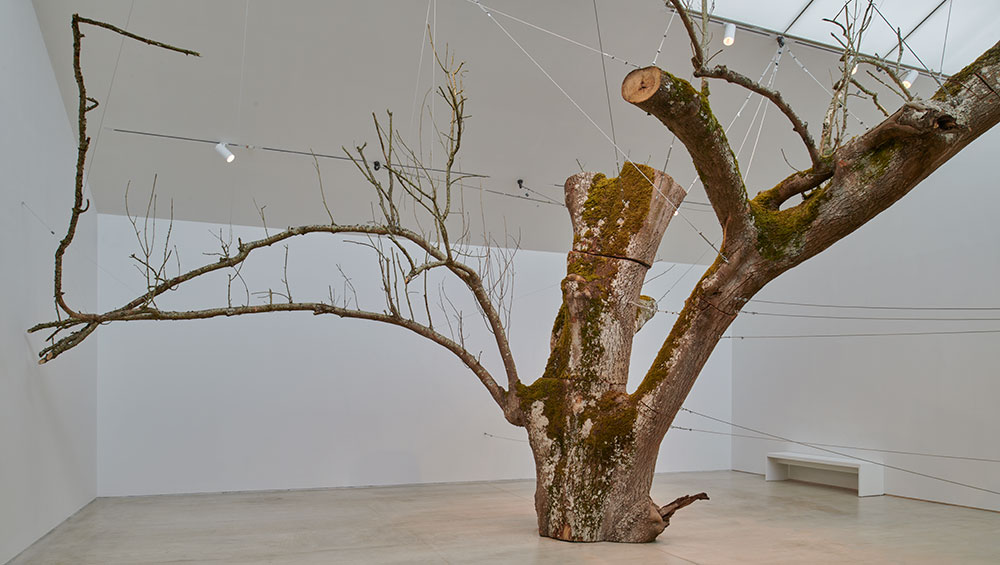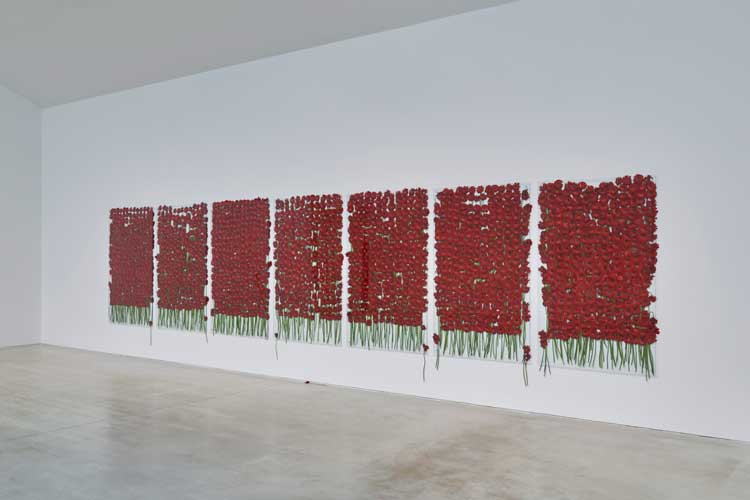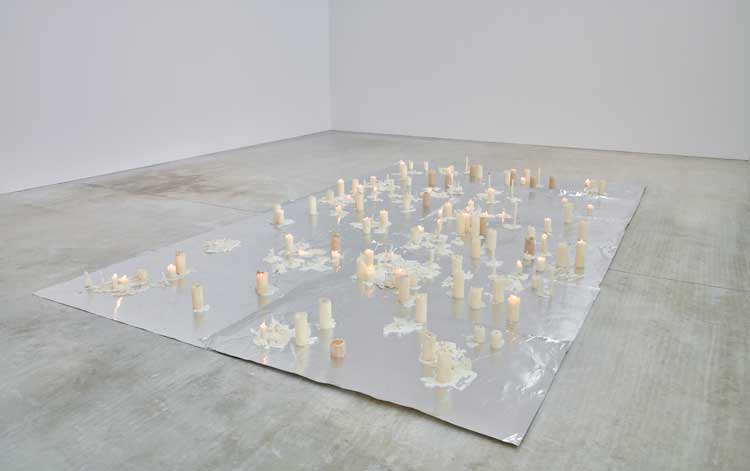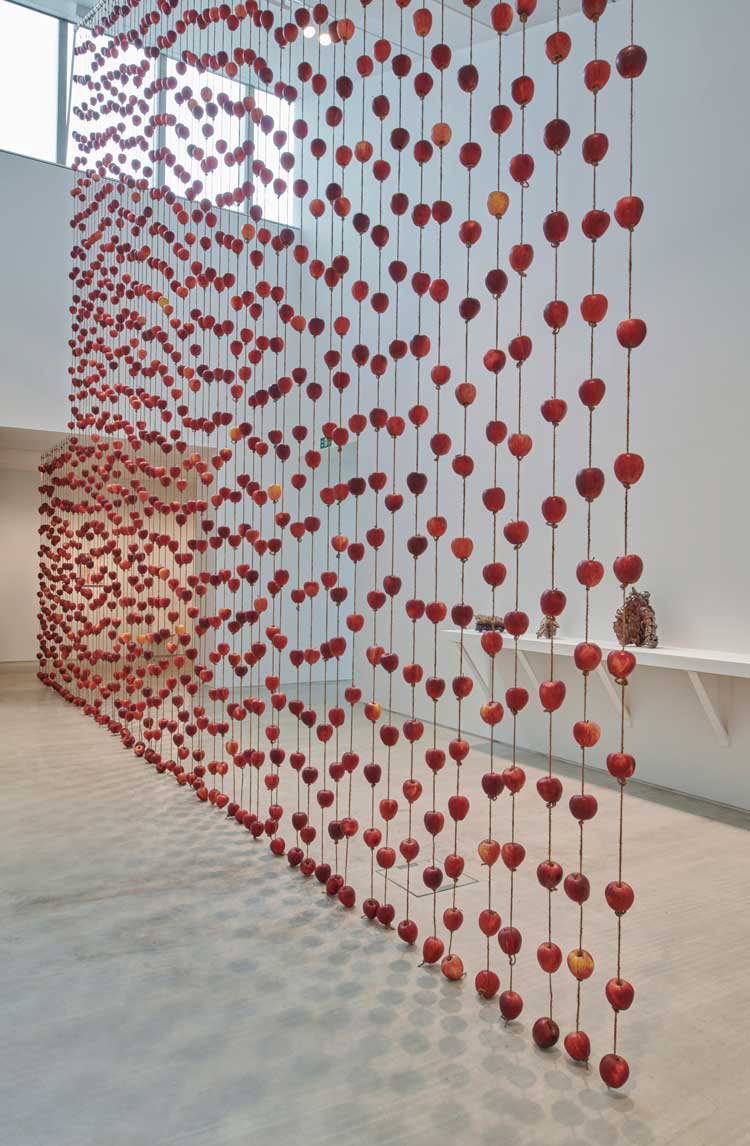
Anya Gallaccio. The inner space within, 2008/2024. Ash tree, bolts, stainless steel. Ash from Lees Court Estate. Installation view, Anya Gallaccio: preserve, Turner Contemporary, 2024. © Anya Gallaccio. Courtesy the artist and Turner Contemporary. Photo: Jo Underhill.
Turner Contemporary, Margate
28 September 2024 – 26 January 2025
by DAVID TRIGG
The rich, red petals of more than 1,700 gerberas have injected a burst of colour into Turner Contemporary this autumn. At least, they did at the opening of Preserve, Anya Gallaccio’s most comprehensive survey show to date. By now, the flowers, which are pressed against the gallery wall by seven rectangular sheets of glass, will have begun to wither and turn brown, eventually leaving behind a mass of putrefying matter. The combining of unstable organic materials with the logic of minimalism has been Gallaccio’s modus operandi for more than 30 years, resulting in works that invite reflection on temporality, entropy and ecological issues. Here, her ephemeral installations incorporating melting candles, felled trees, ageing fruit and decomposing flowers evolve over the course of the exhibition, changing their form from one day to the next.

Anya Gallaccio. Preserve 'Beauty’, 1991/2024. 1700 gerbera held between seven panes of glass and gallery wall. Installation view, Anya Gallaccio: preserve, Turner Contemporary, 2024. © Anya Gallaccio. Courtesy the artist and Turner Contemporary. Photo: Jo Underhill.
Gallaccio’s flowers are ironically titled Preserve “Beauty” (1991/2024). The glass that covers them, which one usually associates with protection, in fact accelerates their decomposition, demonstrating in real time the futility of attempting to maintain that which is transitory. In this they recall 17th-century Dutch vanitas paintings, where flowers and other objects point to the transience of life.

Anya Gallaccio. La Dolce Vita, 1994. Candles, alumninium foil. Installation view, Anya Gallaccio: preserve, Turner Contemporary, 2024. © Anya Gallaccio. Courtesy the artist and Turner Contemporary. Photo: Jo Underhill.
Another motif of the vanitas is the candle, and for La Dolce Vita (1994) Gallaccio has installed a bank of them on to large sheets of foil on the gallery floor. The flickering flames evoke a site of religious veneration, though the accumulating wax also suggests an evolving geology. As with life itself, the work is precarious and unpredictable. But, unlike the human condition, there is no definite end to this piece: the candles are replenished indefinitely.

Anya Gallaccio. Falling from grace, 2000. 2,700 Gala apples, hop twine. Installation view, Anya Gallaccio: preserve, Turner Contemporary, 2024. © Anya Gallaccio. Courtesy the artist and Turner Contemporary. Photo: Jo Underhill.
Several works in the exhibition engage with the natural heritage of Kent, including the elegant Falling from Grace (2000), in which 2,700 Gala apples threaded on lengths of hop twine and suspended from the ceiling form a curtain of fruit that bisects the gallery. Grown locally but deemed too large for supermarkets, these juicy, ripe apples were transported to Turner Contemporary soon after harvesting, though by the end of January, when the exhibition closes, they will be in a much poorer state. Kent is, of course, synonymous with apples and they hold a particular fascination for Gallaccio, who is drawn to their contradictory nature: a product of mother nature yet the result of human intervention through grafting; emblematic of wholesomeness yet a symbol of temptation and sin; perceived to be traditionally British yet originally from Kazakhstan.
Trees are another of Gallaccio’s preoccupations and the showstopper here is The Inner Space Within (2008/2024), the mighty crown of a 107-year-old ash, which dominates an entire gallery space. The tree, which was felled at Lees Court Estate in Faversham as a result of ash dieback disease stretches across the space, its extremities touching the walls. Though securely tethered by taut cables, its sheer size and heft is intimidating; thoughts of being crushed by its gnarly, moss-covered trunk are only exacerbated by the invigilator’s warning not to step too close. But this diseased readymade, cut up and reassembled in the name of art, also elicits pity. After the show, Gallaccio intends to return it to the woods, where it will become a wildlife habitat. For now, it is a sculpture, though where the tree ends and the art begins (and vice versa) is not easily discerned.
,-2024.jpg)
Anya Gallaccio. Beautiful Minds... (dene hole), 2024. Chalk and porcelain, aluminium, pump, software. Dene hole at Lees Court Estate. Installation view, Anya Gallaccio: preserve, Turner Contemporary, 2024. © Anya Gallaccio. Courtesy the artist and Turner Contemporary. Photo: Jo Underhill.
Whereas most of Gallaccio’s works operate in a contemplative register, the installation Beautiful Minds (Dene Hole) (2024) shatters the exhibition’s peaceful atmosphere with a cacophony of mechanical whirring and clunking, as if a mini excavator were trundling through the gallery. The sound is generated by an enormous 3D printer suspended from a large steel frame, which pumps out a mixture of chalk and porcelain, gradually building up an enormous sculptural form layer by layer, day by day. Reflecting Gallaccio’s interest in the impacts of human activity on the landscape, the printer has been programmed to create a scale rendering of the negative space of a Kentish dene hole – an ancient hand-excavated chalk mine that provided communities with agricultural fertiliser and limestone for buildings.
Gallaccio speaks of the printer as a three-dimensional drawing machine, though its output is more like a sketch than a technical rendering. Indeed, whereas the dene hole’s chambers were lidar-scanned to create an accurate three-dimensional map, the expanding sculpture does not precisely replicate the mine’s interior: the consistency of the clay is akin to ice-cream and, as each layer is extruded, it sags under its own weight. A similar 3D-printed clay sculpture was created for Gallaccio’s 2017 exhibition Beautiful Minds at Thomas Dane Gallery, the remnants of which were coated with different slips and fired to create an array of abstract ceramics in various colours and textures. On display here, they resemble geological strata, alien marine creatures and sides of beef.
,-2024-2.jpg)
Anya Gallaccio. Beautiful Minds... (dene hole), 2024. Chalk and porcelain, aluminium, pump, software. Dene hole at Lees Court Estate. Installation view, Anya Gallaccio: preserve, Turner Contemporary, 2024. © Anya Gallaccio. Courtesy the artist and Turner Contemporary. Photo: Jo Underhill.
Unlike her installations, Gallaccio’s ceramics are permanent, marketable objects. For an artist best known for mutable, anti-commercial works, there are a surprising number of static objects in this show, including bronze casts of sprouting potatoes and Jerusalem artichokes, ceramic apples, a hop twine textile hanging and some extraordinary works on paper made using traditional marbling processes with earth pigments from California (where Gallaccio taught at the University of San Diego) and local materials collected in Kent, including mussels, apple tree charcoal, ash and chalk. What links all Gallaccio’s works, whether they endure beyond the exhibition or not, is her interest in the transmutation of materials.
After the show, the wax will be recycled into new candles, the flowers and apples composted for the gallery’s staff garden, and the pips used to plant a crab apple hedge around Gallaccio’s newly created orchard at Lees Court – a living educational resource for local schools that will contain nearly 60 heritage apple tree varieties and support a cross-curricular project in which the arts, sciences and humanities are all taught through the lens of the humble apple. In highlighting sustainability issues and promoting the preservation of ecological heritage, this exhibition lives up to its name, and there is nothing ironic about that.